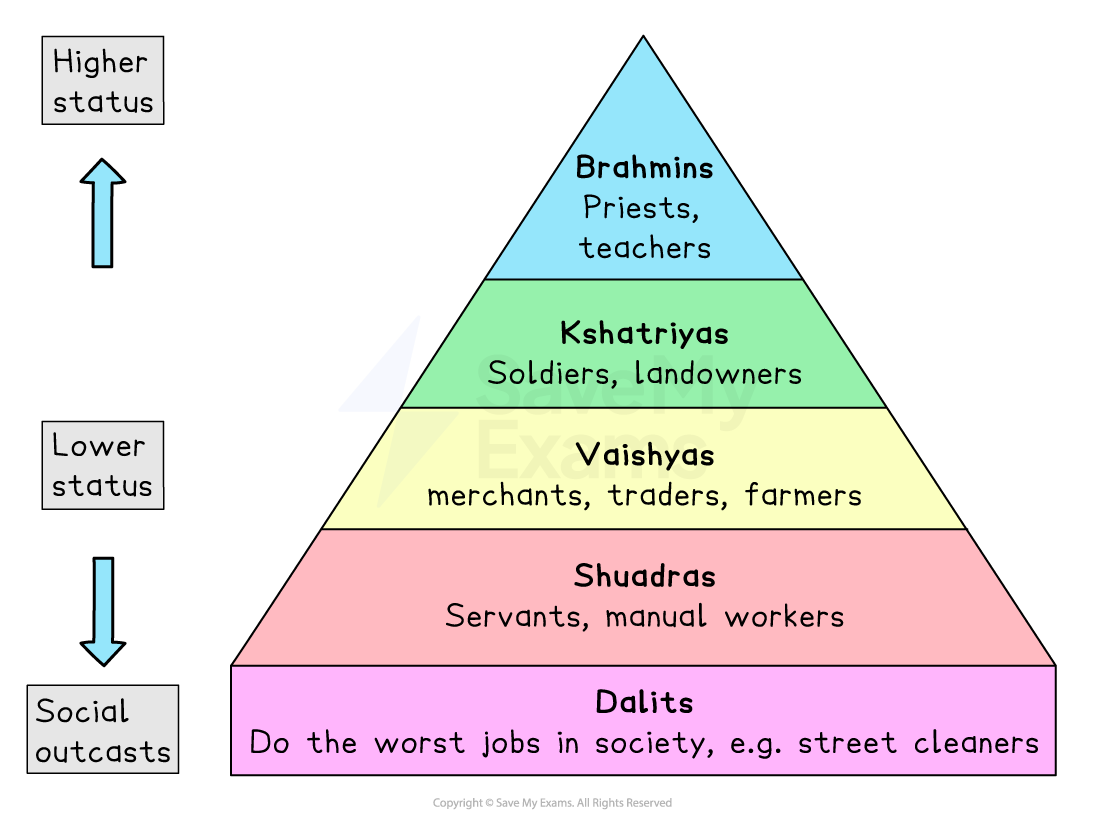Stratification (AQA AS Sociology): Revision Note
Exam code: 7191
What is stratification?
Stratification is the hierarchical layering of society into distinct groups
Stratification involves inequality between groups in the distribution of resources such as wealth, income, status and power
The group at the top of the hierarchy has much more wealth, income, status or power than the one at the bottom
Wealth | Ownership of assets, e.g., property, land, shares and money in savings accounts. |
|---|---|
Income | Cash, e.g., from a salary or company benefits such as use of a company car. |
Status | Social standing or rank of an individual in society due to wealth, career or social influence. |
Power | The ability of an individual or group to get what they want despite opposition from others, e.g., getting a law passed. |
In the UK today, social class is seen as the main form of stratification
Social class is based on economic factors such as occupation and income

How is social class measured?
The government measured social class using the Registrar General's classification of occupations
The Registrar General's social class scale was the official class scale in the UK between 1911 and 1998
It distinguishes between manual and non-manual occupations
Manual occupations require some physical effort and can be skilled, semi-skilled or unskilled and are seen as working-class
Non-manual occupations require no physical effort and include intermediate and professional occupations, which are seen as middle-class
Classes I, II and III (non-manual) were seen as middle class and III (manual), IV and V were seen as working class
The Registrar General's Social Class Scale | |
|---|---|
I | Professional occupations, e.g., solicitors and doctors |
II | Managerial and technical occupations, e.g., teachers, nurses and pilots |
III (N) | Skilled non-manual occupations, e.g. clerical workers, secretaries and receptionists |
III (M) | Skilled manual occupations, e.g. bus drivers, electricians and hairdressers |
IV | Partly skilled occupations, e.g., postal workers, bartenders and caretakers |
V | Unskilled occupations, e.g., labourers and cleaners |
The scale was abandoned because it didn't include:
retired or unemployed people and those who have never worked
those who lived off inherited wealth or property rather than income
those dependent on welfare benefits
The National Statistics Socio-economic Classification (NS-SEC)
The NS-SEC, first used in 2001, replaced the Registrar General's scale as the UK's official measurement of social class
The NS-SEC is also based on occupation, but it includes unemployed people
It groups occupations that have similar:
rewards from work such as pay, benefits (e.g. company car), career prospects and job security
employment status, i.e., employer, employed or self-employed
levels of authority and control, i.e., responsibility for other workers
The NS-SEC Class Scale | |
|---|---|
1 | Higher managerial, administrative and professional occupations, e.g., senior sales managers and solicitors |
2 | Lower managerial, administrative and professional occupations, e.g., social workers and teachers |
3 | Intermediate occupations, e.g., secretaries and computer operators |
4 | Employers in small businesses and own-account workers (self-employed), e.g., farmers |
5 | Lower supervisory and technical occupations, e.g., car mechanics |
6 | Semi-routine occupations, e.g., cooks, bus drivers and sales assistants |
7 | Routine occupations, e.g., waiters, cleaners, and labourers |
8 | Never worked and long-term unemployed |
Different forms of social stratification
Stratification systems differ depending on whether a person's status is ascribed or achieved
Ascribed status: social position is fixed at birth and is unchanging over time, such as being born into the royal family
Achieved status: social position is earned based on personal talent or merit, such as getting all 9s in your GCSEs, which is based on ability and effort
Stratification systems also differ according to how open and closed they are, i.e., how easily social mobility can occur
Open system: An individual's position is achieved, and social mobility can occur, e.g., between social classes
Closed system: An individual's position is ascribed, and social mobility is less likely to occur, e.g., the caste system in India
Caste system in India
The caste system in India is another form of stratification linked to the Hindu religion
Each caste was traditionally associated with particular occupations
Inequality between different groups was justified as stemming from religious beliefs

Examiner Tips and Tricks
Stratification is a core theme in A Level Sociology because it underpins your understanding of inequality across all topics — from education to crime and deviance.
Always link your answers back to how class, gender, and ethnicity shape people's life chances.
Strong students show how theories like Marxism or feminism explain these inequalities and use real-world examples (like the class gap in education or the gender pay gap) to support their points.

Unlock more, it's free!
Did this page help you?